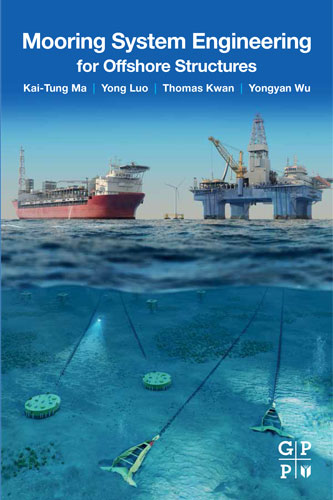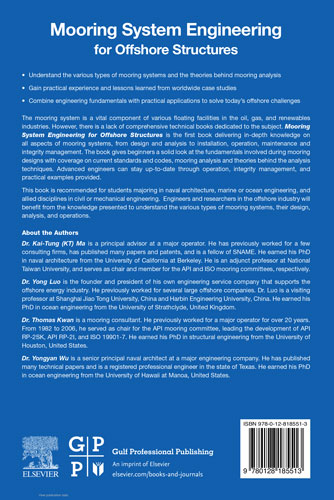Mooring System Engineering for Offshore Structures/Проектирование морских причальных сооружений
Книга на английском языке.
So many of us working in the offshore arena during the last four decades have constantly been challenged by the deceptive complexity of moorings. What to the casual observer looks like a simple structural line element, has, packed within it, every possibly complexity in concept (catenary, semi-taut, taut), material (chain, steel wire, fiber), and analysis (time domain, frequency domain, hybrid, extreme, fatigue, creep) to challenge the designer. From rules of thumb, we have moved to highly complex, precise and accurate analysis accounting for multiple physical processes in ultradeep waters reaching 3 km. In terms of equipment, the offshore industry has accelerated the move from simple mooring equipment from three millennia of shipping history to the most ingenious anchors and winches.
The book comes at a critical juncture in the energy transition. In the last nearly three-quarter century of offshore hydrocarbon exploration and production, electricity from renewable energy sources has gone from nearly zero to 25% of world production. A rapidly increasing contributor to that is offshore wind. While offshore wind energy has made a major impact in Europe using fixed substructures, its global impact will only come with moored floating offshore wind in the Americas and Asia, in deeper waters. It is therefore gratifying to see that the authors have addressed this topic in a specific chapter in this book. This work will go towards bridging the knowledge transition between offshore oil and gas and offshore wind.
Contets
Chapter 1 Introduction
Chapter Outline
1.1 Overview
1.2 History of offshore mooring
1.3 Floating drilling enabled by mooring
1.4 Floating production enabled by mooring
1.5 Differences between drilling and production
1.6 Floating wind turbine
1.7 Questions
References
Chapter 2 Types of mooring systems
Chapter Outline
2.1 Overview
2.2 Spread mooring system
2.3 Single-point mooring system
2.4 Other types of single-point mooring system
2.5 Dynamic positioning and thruster-assisted systems
2.6 Questions
References
Chapter 3 Environmental loads and vessel motions
Chapter Outline
3.1 Loads on floating structures
3.2 Wind load
3.3 Wave load and vessel motions
3.4 Current load and vortexinduced motion
3.5 Ice load
3.6 Other topics on environment loads
3.7 Questions
References
Chapter 4 Mooring design
Chapter Outline
4.1 Design basis
4.2 Design process
4.3 Design considerations
4.4 Design criteria
4.5 Engineering analysis and code check
4.6 Questions
References
Chapter 5 Mooring analysis
Chapter Outline
5.1 Theoretical background
5.2 System modeling
5.3 Modeling of polyester rope stiffness
5.4 Quasistatic or dynamic analyses
5.5 Strength analysis in frequency domain
5.6 Strength analysis in time-domain
5.7 Uncoupled and coupled analyses
5.8 Response-based analysis
5.9 Mooring software
5.10 Questions
References
Chapter 6 Fatigue analysis
Chapter Outline
6.1 Overview
6.2 Fatigue resistance of mooring components
6.3 Fatigue analysis in frequency domain
6.4 Fatigue analysis in time domain
6.5 Fatigue analysis procedure
6.6 Vortex-induced motion fatigue
6.7 Out-of-plane bending fatigue for chain
6.8 Questions
References
Chapter 7 Model tests
Chapter Outline
7.1 Types of model tests
7.2 Principle of model test
7.3 Capability of model basin facilities
7.4 Limitations of model test
7.5 Mooring system truncation
7.6 Hybrid test method
7.7 Model test execution
7.8 Questions
References
Chapter 8 Anchor selection
Chapter Outline
8.1 Overview
8.2 Suction piles
8.3 Driven piles
8.4 Drag embedment anchors
8.5 Vertically loaded anchors
8.6 Suction embedded plate anchors
8.7 Gravity installed anchors
8.8 Questions
References
Chapter 9 Hardware - off-vessel components
Chapter Outline
9.1 Mooring line compositions
9.2 Chain
9.3 Wire rope
9.4 Polyester rope
9.5 Other synthetic ropes
9.6 Connectors
9.7 Buoy
9.8 Clump weight
9.9 Questions
References
Chapter 10 Hardware - on-vessel equipment
Chapter Outline
10.1 Tensioning systems
10.2 Chain jack
10.3 Chain windlass
10.4 Wire winch
10.5 In-line tensioner
10.6 Summary
10.7 Questions
References
Chapter 11 Installation
Chapter Outline
11.1 Site investigation
11.2 Installation of permanent mooring
11.3 Deployment and retrieval of temporary mooring
11.4 Installation vessel
11.5 Questions
References
Chapter 12 Inspection and monitoring
Chapter Outline
12.1 Inspection
12.2 Inspection schedule
12.3 Inspection methods
12.4 Inspection of mooring components
12.5 Monitoring
12.6 Monitoring methods
12.7 Monitoring devices
12.8 Questions
References
Chapter 13 Mooring reliability
Chapter Outline
13.1 Mooring failures around the world
13.2 Probability of failure for permanent moorings
13.3 Failure spots for permanent moorings
13.4 Probability of failure for temporary moorings
13.5 Failure spots for temporary moorings
13.6 Reliability of mooring components
13.7 Wide variety of failure mechanisms
13.8 Questions
References
Chapter 14 Integrity management
Chapter Outline
14.1 Mooring integrity management
14.2 Incident response
14.3 Life extension
14.4 Ways to improve mooring integrity
14.5 Questions
References
Chapter 15 Mooring for floating wind turbines
Chapter Outline
15.1 Concepts of floating offshore wind turbines
15.2 Mooring design
15.3 Mooring design criteria
15.4 Mooring analysis
15.5 Design considerations
15.6 Questions
References
Index




